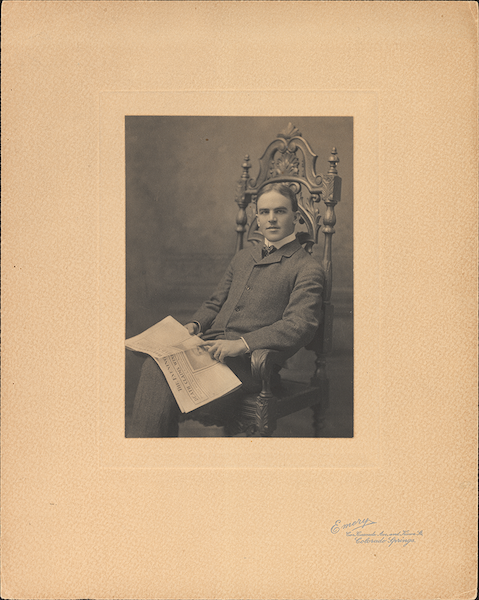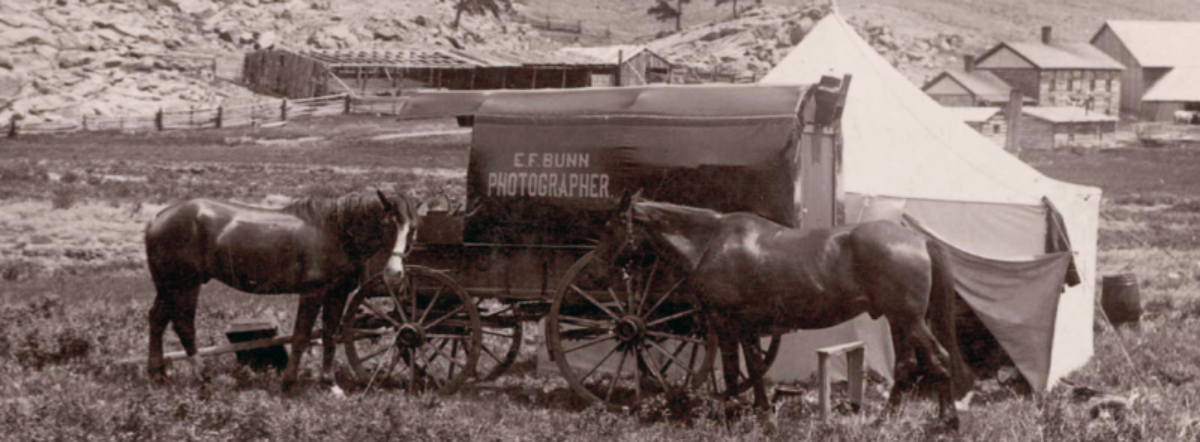Charles Eckland was born on December 3, 1859 in Sweden. He arrived in the United States as a young boy. After the death of his father, Charles was adopted by Ard Godfrey Emery, a Michigan photographer. Charles Emery attended schools in Michigan and Illinois. He started working in his adopted father’s studio by the age of sixteen.
At age twenty, Charles Emery arrived in Silver Cliff, Colorado with a solid background in photography. He opened a studio on the corner of Main and Mill Streets, beginning a distinguished photography career that would span more than five decades in multiple cities and encompass a wide range of photographic processes.
By 1880, Silver Cliff had become the third largest city in the state due to its silver mines. Soon after Emery’s arrival, smoke from a forest fire in a nearby gulch looked like snow on top of the mountains. The scene so captivated the city’s population that they closed stores and offices in order to view the sight. Emery made stereoviews of the mountain scene, which he later sold by the hundreds for fifty cents apiece. This brought his work to national attention. He immediately submitted one stereoview to the U. S. Copyright Office housed at the Library of Congress in Washington, D.C.

Not content with limiting himself to studio portraits, Emery traveled to many locations around Colorado, including Garden of the Gods, Manitou and Pike’s Peak, Glen Eyrie, Denver, Clear Creek Canon, Ute Pass and Rainbow Falls, Grand Canon of the Arkansas, the Wet Mountains and the Sangre de Cristo Range, producing stereoviews and landscape views printed on boudoir cards. (Boudoir cards are prints slightly larger than cabinet cards.) He offered the views for sale at his gallery and through a catalog which is no longer extant.
On June 11, 1884, Emery married Bertha Alba Francis. Bertha’s brother, Gowen D. Francis, worked as Emery’s assistant. Bertha was a notable musician who played the organ for services at the local Methodist Episcopal church. After the wedding, the couple traveled by train to Manitou and Denver, and then to Kansas to visit Emery’s parents. Charles and Bertha would have seven children, only five living into adulthood.
In 1885, Emery moved his studio to Canon City, Colorado, but made monthly visits to Westcliffe, just west of Silver Cliff, to make studio portraits. Emery photographed prisoners in the original State Penitentiary located in Canon City, including images of prisoners in the chapel and a prisoner posed seated at a desk in the warden’s office.

In 1892, Emery purchased the photographic studio of D. B. Chase in Colorado Springs. He worked in the Springs for nearly forty years. At this studio, he specialized in portrait photography, often making class portraits for Colorado College. On request, Emery made portraits in people’s homes. He also sold Kodak cameras and photographic supplies for amateur photographers.

Emery attended the 1898 convention of the National Photographers Association of America, held at Chatauqua Lake, N. Y. The meeting provided an opportunity for him to learn new skills and see new equipment that might benefit his studio. Whenever in the East, he would also visit the leading studios to see their operations first-hand, to acquire ideas for his business. In 1901, Emery opened a studio custom designed for his needs, at the corner of Cascade and Kiowa Streets and ordered new studio backgrounds painted by a famous New York artist.

Emery exhibited about a dozen photographs in San Francisco at the 1903 Photographers’ Association of California. The following year he attended the National Photographers Association in Kansas City, and while there, visited the Worlds’ Fair.
In 1905, President Teddy Roosevelt participated in a hunting trip in Garfield County, Colorado. P. B. Stewart, an amateur photographer from Colorado Springs, accompanied the trip and made Kodak views. Emery processed the negatives and photographs an produced a personal album, made especially for President Roosevelt. The album is now held by Harvard University.

Emery’s work was included in the “Temple of Childhood”exhibition held in conjunction with the Panama-Pacific International Exhibition held in San Francisco in 1915. Another acknowledgment of his success came with his inclusion in “Who’s Who in Professional Portraiture in America,” published in 1927. The volume contained biographies of three hundred American photographers, including Arnold Genthe and Pirie McDonald.
The Emery family suffered a tragic loss in August 1929. They were staying at their cottage outside Colorado Springs when heavy rain caused a dam to burst above the camp. Charles and his wife, Bertha, ran to the neighboring cottages to alert their friends to seek higher ground. Bertha was swept away by the flood waters and drowned. Charles never recovered from his wife’s death. On September 1, 1932, three years after her death, Charles was found dead in his garage from carbon monoxide poisoning. The Emerys were buried side-by-side in Colorado Springs’ Evergreen Cemetery.
Thank you to Beverly W. Brannan, former curator of photography at the Library of Congress for editing this post. Daniel Davidson, Director of the Museum of Northwest Colorado brought Emery’s photographs of prisoners to my attention. Keegan Martin, Digital Imagining Technician, History Colorado and Neylan Wheat, Museum of Northwest Colorado provided scans. Jessy Randall, Curator and Archivist, Special Collections, Tutt Library, Colorado College granted permission to use photographs from the collection.
